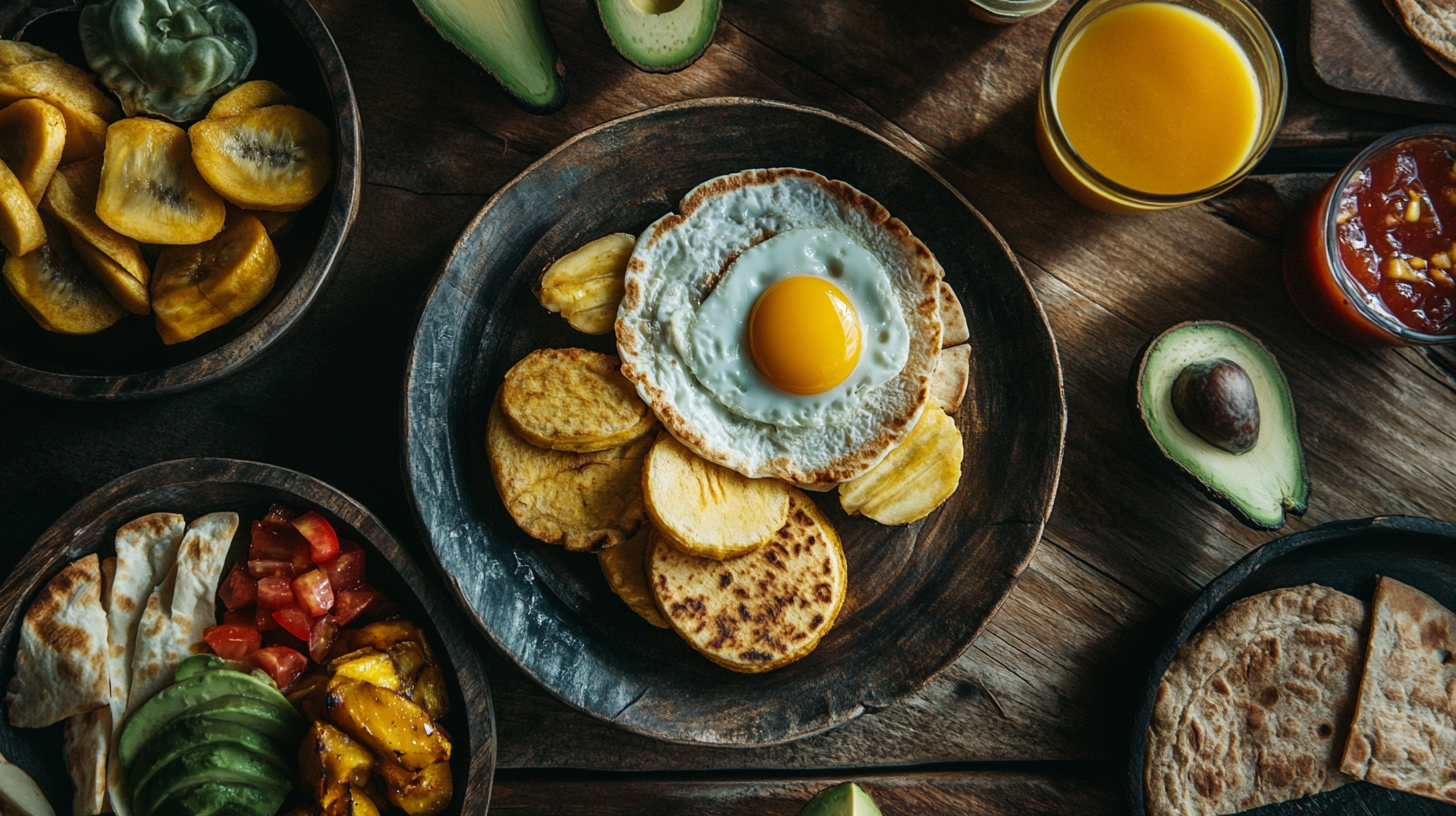If you think breakfast is just a quick bite before work, you’ve never experienced a Colombian breakfast. This isn’t your standard toast and coffee—Colombians go all in. We’re talking hearty, comforting meals that blend indigenous flavors with Spanish influence, creating morning dishes you’ll dream about long after breakfast ends. Whether you’re craving crispy arepas or creamy changua, this is your perfect intro to a world of flavor that turns mornings into a celebration.
Table of Contents
What Makes Colombian Breakfast So Irresistible?
The first thing you’ll notice about a Colombian breakfast is how satisfying it feels. There’s always a generous portion of carbs (hello, arepas and rice), protein (usually eggs or beef), and something fresh like avocado or fruit. The meals are warm, comforting, and meant to be enjoyed—not rushed. Breakfast in Colombia is all about fueling the body while sharing time with family or friends, especially on weekends.
A Brief Cultural Backdrop
Colombia’s rich cultural tapestry shows up beautifully at the breakfast table. Influences from Afro-Caribbean, Andean, and Spanish traditions all mingle here. For example, Calentado Paisa—a fried rice and beans dish—is rooted in the Andean regions, while Arepas are a shared heritage across Venezuela and Colombia, customized by region. The Caribbean coast leans toward tropical ingredients and lighter meals, while mountainous regions go heavy and hearty.
Why Breakfast is a Big Deal in Colombia
In many Colombian households, breakfast is considered the most important meal of the day. Especially in rural areas, people begin their days early with physically demanding tasks—so breakfast has to deliver. That’s why dishes like Calentado or Tamal Tolimense are packed with calories, protein, and carbs. It’s all about long-lasting energy. You’ll rarely see sugary cereals or smoothies here; instead, you’ll get a hot, home-cooked meal that sets the tone for the day.
The vibe is very different from the grab-and-go culture found in the U.S. or Europe. Even in the cities, locals will sit down for arepas with hot chocolate, or stop at street stalls for freshly made empanadas and jugos (fruit juices). And don’t be surprised to find cheese in your hot chocolate—that’s a Colombian twist you didn’t know you needed!
This culture of slow, intentional eating in the morning is something we could all learn from. Want to add some protein to your breakfast with a twist? Try mixing in one of these chicken breakfast recipes if you’re blending flavors or customizing arepas.
Key Ingredients in Traditional Colombian Breakfast
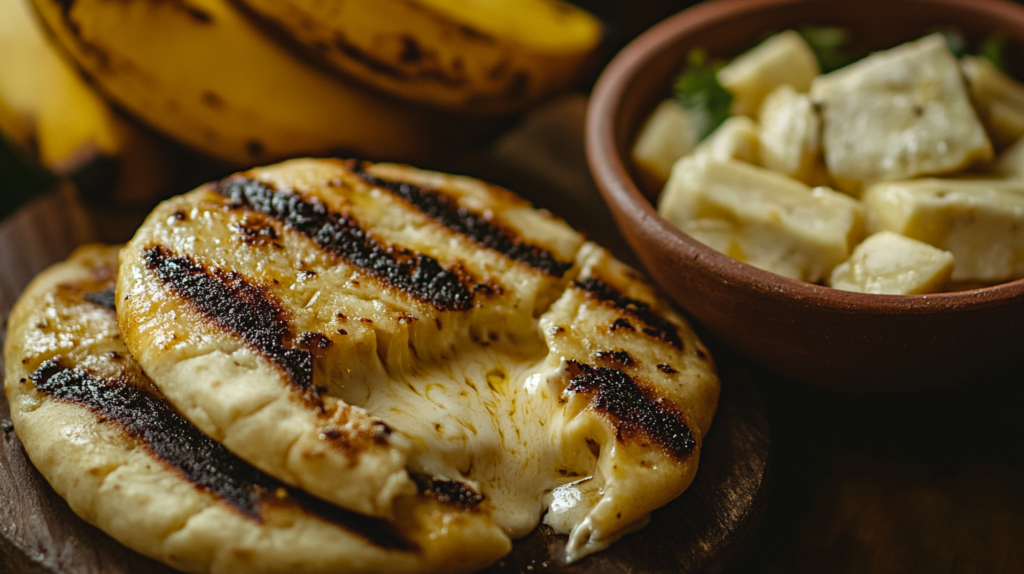
So, what makes a Colombian breakfast so unique? It’s all about the ingredients. Whether you’re in a Bogotá apartment or a rural Antioquian farmhouse, there are a few staples you’ll see over and over. And trust me, once you get familiar with them, your mornings will never be the same.
Plantains, Arepas, and Cheese Galore
Let’s start with the holy trinity: plantains, arepas, and cheese. These three show up everywhere.
- Arepas are the backbone of Colombian breakfasts. They’re cornmeal patties that are grilled, baked, or fried. You can eat them plain, stuffed with cheese, or topped with eggs, butter, and avocado. Some are crispy; others are soft and thick. Basically, there’s an arepa for every mood.
- Cheese in Colombian breakfast? Oh yes. Colombians love their dairy. Fresh, salty white cheese (queso fresco) is often melted inside arepas or dropped right into your hot chocolate—yep, seriously. The combo is surprisingly addictive.
- Plantains are either sweet (maduros) or savory (patacones), and they’re usually fried to golden perfection. You’ll often find them alongside eggs or meats, giving a perfect contrast of textures and flavors.
These ingredients aren’t just flavorful—they’re filling, which fits right into the Colombian ethos of breakfast being a hearty, energizing meal.
Tropical Fruits and Fresh Juices
If you’re a fruit lover, a Colombian breakfast will feel like paradise. The country’s biodiversity gives it access to fruits you’ve probably never tried (or heard of). Think lulo, guanabana, maracuyá (passion fruit), papaya, and pitaya (dragon fruit). These are either eaten fresh or blended into jugos naturales—natural fruit juices that accompany pretty much every breakfast.
Jugos can be served with milk or water, depending on your taste. Lulo with water is refreshing and tart, while guanabana with milk is creamy and sweet. And no sugar bombs here—most Colombians like to taste the fruit itself.
Pair your meal with one of these vibrant juices and you’ll start your day on a bright, fruity note. If you’re feeling adventurous, you can even fuse this experience with your own breakfast creations. Consider trying something like a tropical twist on these low-sodium chicken recipes for a healthier spin that still packs flavor.
So before diving into actual recipes, just remember: Colombian breakfasts are more about ingredients that nourish than flavors that shock. The magic is in the balance—crispy arepas, creamy cheese, sweet fruit, and bold juices all come together in a joyful, morning feast.
Must-Try Classic Colombian Breakfast Dishes
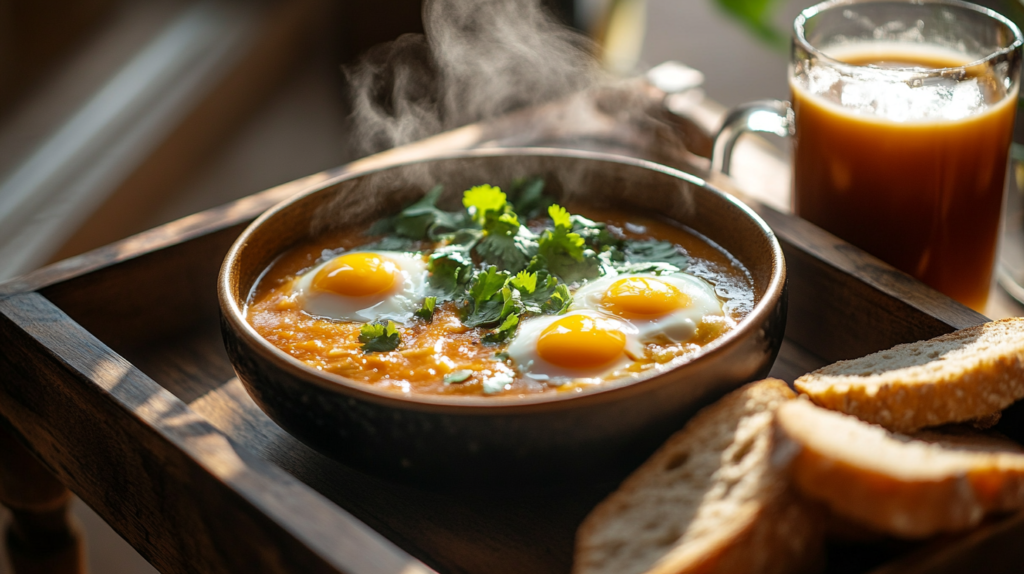
Now that you’ve got the ingredients down, let’s talk about the real stars of the show—Colombian breakfast dishes that define the culture. These aren’t just meals; they’re rituals. Comforting, filling, and full of history, each dish tells its own story. And lucky for you, they’re also incredibly delicious.
Arepa con Queso
Arguably the most famous Colombian breakfast item, this dish is simple but soul-satisfying. Arepa con queso is a corn cake stuffed or topped with melted cheese, sometimes grilled to a slight crisp on the outside while keeping the inside soft and gooey. You’ll find it at street carts, homes, and even fancy cafes across Colombia.
Want to give it a twist? Swap in shredded chicken and you’ve got a protein-packed breakfast version—similar to the concept behind these chicken cutlet sandwich recipes but with a Colombian soul.
Calentado Paisa
Literally translating to “heated-up Paisa-style,” Calentado is the ultimate leftover makeover. It’s typically made from last night’s rice, beans, and meat—all fried together and topped with a fried egg. This rustic dish is especially beloved in the Antioquia region. It’s comforting, full of flavor, and honestly, the best way to use leftovers.
If you’ve got leftover grilled chicken from dinner, this is where you toss it in. It’ll soak up the flavors and make the dish even more filling—kind of like these smoked chicken leftover recipes.
Changua (Colombian Egg and Milk Soup)
This one’s a bit unusual but stick with me. Changua is a breakfast soup made with milk, water, eggs, scallions, and cilantro. It’s creamy, savory, and surprisingly light. The egg is poached directly in the broth and served with chunks of stale bread or arepas on the side.
It’s one of those dishes you crave on cold mornings. And yes, the idea of milk-based soup might sound strange, but it works. Think of it like a hug in a bowl.
Tamal Tolimense
Tamales in Colombia are often enjoyed at breakfast, especially on weekends or holidays. The Tamal Tolimense is a regional version wrapped in plantain leaves and filled with corn dough, rice, vegetables, and chicken. It’s steamed for hours and has a deeply comforting flavor.
It’s not a quick dish, but it’s worth every second. If you’re already in love with stuffed foods, this dish hits similar satisfaction levels as a chicken pastry—but with a tropical, earthy twist.
Easy Colombian Breakfast Recipes to Try at Home
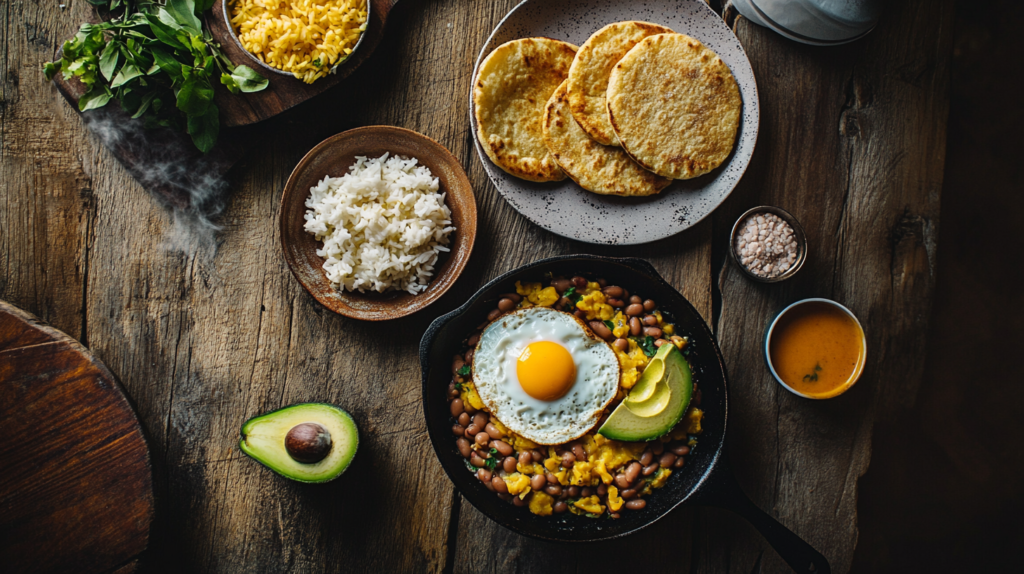
You don’t need to hop on a flight to Bogotá to enjoy an authentic Colombian breakfast. With just a few simple ingredients and the right techniques, you can whip up these classics right in your own kitchen. These recipes are beginner-friendly and full of bold, comforting flavor—perfect for weekend brunch or a weekday treat.
Quick Arepas with Cheese Filling
Arepas are the perfect blank canvas, and making them at home is easier than you think. Here’s a super simple version stuffed with melty cheese:
Prep Time: 10 mins
Cook Time: 10 mins
Total Time: 20 mins
Servings: 4
Ingredients:
- 2 cups pre-cooked cornmeal (masarepa or arepa flour)
- 2 ½ cups warm water
- 1 tsp salt
- 1 ½ cups shredded mozzarella or queso fresco
- Butter for pan-frying
Instructions:
- In a bowl, mix warm water with salt. Gradually stir in the cornmeal until dough forms.
- Let the dough rest for 5 minutes, then divide into 8 equal balls.
- Flatten each ball and add cheese to the center of half the patties.
- Top with another patty and seal the edges, forming thick disks.
- Heat butter in a skillet over medium heat. Cook arepas for 4–5 minutes per side until golden and crispy.
- Serve warm with more cheese or avocado slices.
For a protein-packed upgrade, try folding in shredded chicken—just like you’d see in these grilled chicken wrap recipes for a complete, balanced bite.
Simple Calentado with Leftovers
Calentado is a Colombian breakfast hack you’ll love for its zero-waste vibe and maximum flavor. It’s a genius way to transform last night’s dinner into something totally new.
Prep Time: 5 mins
Cook Time: 10 mins
Total Time: 15 mins
Servings: 2
Ingredients:
- 1 cup cooked rice
- 1 cup cooked beans
- ½ cup shredded cooked meat (like chicken or beef)
- 2 eggs
- 1 tbsp oil
- Salt and pepper to taste
- Optional: sliced avocado, fresh cilantro
Instructions:
- Heat oil in a skillet. Add rice and beans, stirring to combine.
- Add shredded meat and cook until everything is heated through and lightly crispy.
- In the same pan, make space and crack in two eggs. Fry until the whites are set.
- Serve with sliced avocado, a sprinkle of cilantro, and maybe some hot sauce.
This one’s a lifesaver when you’ve got leftover protein. Got some crockpot chicken pasta leftovers? Toss them in! No rules, just bold Colombian flavor.
Modern Colombian Breakfast Twists
While traditional dishes reign supreme, there’s a new wave of creative Colombian breakfast takes that blend old-school ingredients with contemporary flair. Whether you’re into clean eating, experimenting with textures, or just craving something new, these reinvented dishes keep the spirit of Colombian mornings alive—just with a twist.
Plantain Pancakes
Colombians already love plantains, but turning them into pancakes? That’s a game-changer.
These plantain pancakes use ripe plantains for a naturally sweet, gluten-free base. They’re soft, golden, and perfect with honey, fruit, or a savory egg on top.
Quick How-To:
- Mash 2 ripe plantains.
- Mix with 2 eggs, a splash of milk, cinnamon, and a pinch of salt.
- Cook on a non-stick skillet for 2–3 minutes per side.
Want protein? Add shredded chicken or a side of these bariatric chicken recipes for a balanced bite that keeps you full.
Arepa Breakfast Sandwich
Meet your new go-to breakfast sandwich—Colombian-style. Instead of bread, use crispy arepas sliced horizontally and filled with scrambled eggs, avocado, and your protein of choice. It’s satisfying, handheld, and packed with that distinct arepa texture.
This modern Colombian breakfast twist is perfect for meal prepping or even freezing and toasting later. You can go classic with cheese and tomato or bold with chicken and hot honey sauce like in this hot honey chicken tenders recipe.
Vegetarian and Vegan Colombian Breakfast Options
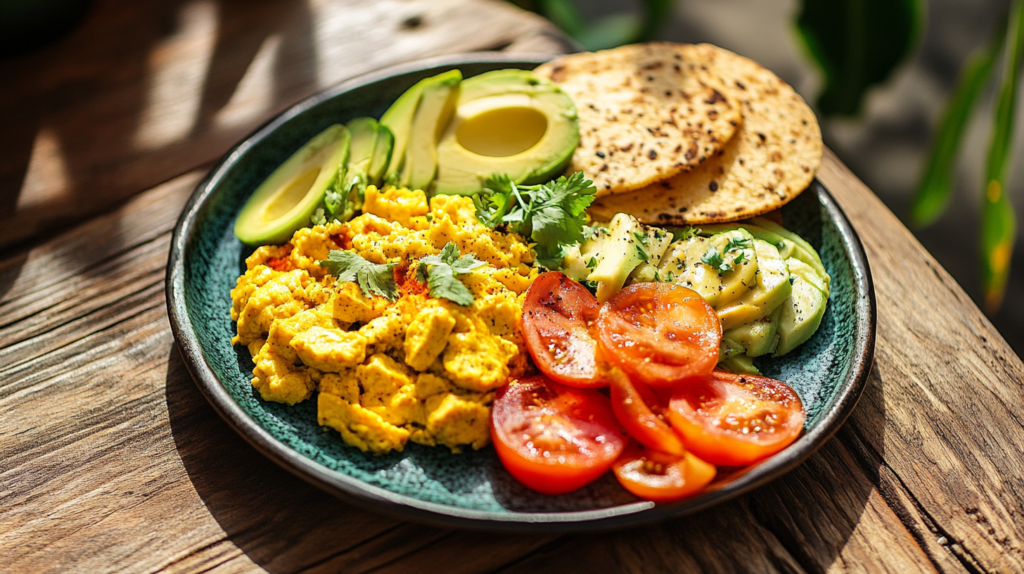
If you thought traditional Colombian food couldn’t be plant-based, think again. Many dishes are already vegetarian by nature, and others are easy to adapt.
Tofu Scramble Arepas
Substitute scrambled eggs with turmeric-spiced tofu and layer into an arepa for a colorful, hearty, and completely vegan meal. Add grilled onions, avocado, and a splash of hot sauce—perfection.
You’ll be amazed how the texture of tofu mimics egg, and the crispy arepa gives the perfect crunch. Bonus: it’s packed with protein and entirely dairy-free.
Vegan Changua
Yes, even creamy Changua can go vegan. Use oat milk or almond milk, skip the egg, and add mushrooms for that umami richness. A splash of coconut milk adds depth, and chopped scallions and herbs keep it authentic.
Serve it with crusty bread or dairy-free arepas. It’s soothing, warm, and totally comforting—the vegan way.
Looking to get more adventurous? Add in spiced chickpeas or go fusion-style with flavors from these Indian-inspired ground chicken recipes (without the chicken) for an exciting plant-based remix.
Where to Eat Colombian Breakfast (If You Visit)
If you’re lucky enough to travel to Colombia, eating an authentic Colombian breakfast in its natural habitat is a must. While you’ll find tasty options across the country, here are a few cities where the morning meal game is strong.
Best Spots in Bogotá, Medellín & Cartagena
- Bogotá: Head to La Puerta Falsa—a centuries-old eatery serving up traditional changua and tamales in a cozy, historic setting.
- Medellín: In the city of eternal spring, check out El Rancherito or street stalls around Laureles for piping hot arepas and fresh fruit juices.
- Cartagena: Being coastal, expect lighter breakfasts here. Try La Mulata for fresh fish arepas and jugos made from exotic Caribbean fruits.
If you’re visiting or exploring the flavors of Colombia from home, be sure to take inspiration from these traditional breakfasts—and maybe pair them with something hearty like Knorr chicken and rice for lunch.
Tips for Making the Ultimate Colombian Breakfast at Home
Where to Find Ingredients Outside Colombia
You don’t need to live in Bogotá to enjoy a Colombian breakfast. Look for Latin or international grocery stores near you. Key items like masarepa (arepa flour), queso fresco, and tropical fruits are often available in well-stocked ethnic sections or online. You can also experiment with substitutes—like using polenta for arepas or feta for a salty cheese twist.
Cooking Tips from Colombian Grandmas
Want to keep it real? Here are some abuela-approved tips:
- Never rush the arepas. Let the dough rest so they get the right texture—soft inside, crisp outside.
- Add cheese at the end. Don’t overcook it or it turns rubbery.
- Balance is everything. Make sure each plate has something hot, something fresh, and something sweet or creamy (like fruit or chocolate caliente).
If you’re feeling bold, blend a little inspiration from this chicken cottage cheese recipe into an arepa sandwich for a creamy-protein-packed variation.
Common Mistakes to Avoid with Colombian Breakfast
Even though the recipes are simple, a few common missteps can mess with the magic:
Misunderstanding Arepas
Arepas aren’t just flatbread—they have texture and flavor that depends on the cornmeal type and moisture level. Don’t use regular cornmeal or skip the resting step.
Overcomplicating Simple Dishes
You don’t need to add five sauces or a dozen toppings. Colombian food is about balance and simplicity. A well-cooked arepa or tamal doesn’t need bells and whistles—it shines on its own.
Stick to the basics, enjoy the process, and you’ll be amazed at how satisfying a simple Colombian breakfast can be.
Frequently Asked Questions About Colombian Breakfast
1. What is a typical Colombian breakfast?
A typical Colombian breakfast includes arepas (corn cakes), eggs, cheese, and sometimes rice and beans. It’s a hearty, comforting meal often served with fresh fruit and hot chocolate or juice. In many regions, dishes like changua (a milk and egg soup) or calentado (a rice and bean stir-fry) are popular staples. It’s all about combining carbs, protein, and fresh elements for a filling start to the day.
2. Is Colombian breakfast healthy?
Yes, a Colombian breakfast can be quite healthy, especially when based on whole foods. Arepas are naturally gluten-free, and dishes often include fresh fruit, eggs, avocado, and beans. It’s balanced, nutrient-rich, and packed with fiber and protein. While some versions (like tamales or fried plantains) are heavier, there are plenty of light, wholesome options to suit any diet.
3. What do Colombians drink for breakfast?
Popular drinks for a Colombian breakfast include chocolate caliente (hot chocolate often served with cheese), café con leche (coffee with milk), and jugos naturales (fresh fruit juices). The juices are made from tropical fruits like lulo, papaya, and guanabana, blended with water or milk. These drinks balance the savory and starchy elements of the meal and add a refreshing or cozy finish.
4. Can I make Colombian breakfast with ingredients I already have?
Absolutely! A homemade Colombian breakfast can be built using ingredients like eggs, rice, beans, cheese, and any type of flatbread or cornmeal. While traditional ingredients like masarepa or tropical fruits elevate the experience, you can easily substitute with what’s available. Leftovers also come in handy for dishes like calentado. The key is to balance flavors and textures, not replicate every ingredient perfectly.
5. Are there vegetarian or vegan Colombian breakfast options?
Definitely! Many Colombian breakfast dishes are easy to make vegetarian or vegan. For example, arepas can be filled with plant-based cheese or avocado. Changua can be made with plant-based milk and mushrooms instead of eggs. Tofu scrambles and fruit-based dishes are also popular in modern versions. The natural simplicity of Colombian breakfasts makes them flexible for various diets.
6. What is a typical breakfast in Colombia?
A typical Colombian breakfast is warm, hearty, and designed to keep you full for hours. Common components include arepas, eggs, cheese, and fresh tropical juices. Regional dishes like changua (a milk-based egg soup), tamales, or calentado (rice and beans with eggs) also make frequent appearances. It’s not uncommon to see sliced avocado, fried plantains, or hot chocolate served alongside. The meal is meant to be nourishing and satisfying—more than just a quick snack.
7. What is the average breakfast in Colombia?
The average Colombian breakfast often includes a simple yet filling combination of arepas with cheese or butter, scrambled or fried eggs, and fruit or juice. While weekends may involve more elaborate meals like tamales or calentado, most weekdays feature quick yet nutritious items. A cup of café con leche or chocolate caliente often rounds out the meal. It’s a comforting start to the day that varies slightly by region and household.
8. What is a Colombian rice breakfast dish?
Calentado is the most well-known Colombian breakfast dish featuring rice. It’s made by reheating (hence the name) leftover rice and beans, sometimes with meat, and topping it all off with a fried egg. It’s especially popular in the Paisa region and is known for being resourceful, filling, and delicious. Think of it as Colombia’s answer to a breakfast hash—but with Latin flavor and bold textures.
9. What is a traditional Colombian meal?
A traditional Colombian meal typically centers around balance and heartiness. While Colombian breakfast sets the tone with arepas, eggs, and fruit, lunch is usually the biggest meal of the day. Dishes often include rice, beans, plantains, salad, and some form of protein like chicken, beef, or fish. Bandeja Paisa, Colombia’s national dish, combines all these elements on one plate. Dinner tends to be lighter, often a repeat of lunch or something quick like soup or arepas.
Conclusion
When it comes to bold, comforting, and satisfying morning meals, nothing quite compares to a Colombian breakfast. Whether you’re enjoying a cheesy arepa hot off the griddle, sipping creamy changua on a rainy day, or digging into a reheated plate of calentado, each dish reflects Colombia’s deep culinary roots and love for hearty, well-balanced food. It’s more than a meal—it’s a ritual, a way of gathering and starting the day with intention.
The best part? You don’t have to be in Colombia to experience it. With simple ingredients and a bit of know-how, anyone can bring these flavorful traditions to life at home. From traditional staples to vegan twists and modern remixes, the Colombian breakfast has something for every palate and every diet.
Ready to transform your mornings? Pick a recipe, prep your arepas, and treat yourself to a breakfast that’s anything but ordinary.

